Readings Newsletter
Become a Readings Member to make your shopping experience even easier.
Sign in or sign up for free!
You’re not far away from qualifying for FREE standard shipping within Australia
You’ve qualified for FREE standard shipping within Australia
The cart is loading…






Investments on the order of US$6 billion are estimated to be needed in the water sector in Nigeria in the next 10 years if the country is to achieve universal water supply coverage. This is the main finding of State Water Agencies in Nigeria: A Performance Assessment, in which the objective is to provide the government of Nigeria with a structured and coherent quantitative snapshot of the state of its urban water sector. The report focuses on water provision services from the States’ Water Authorities or Water Boards (SWAs) as they are the major and only regulated agencies that provide water to the urban population. Sanitation provision is not addressed because the majority of SWAs do not provide this service to their customers. This report highlights the issues related to the performance of SWAs, tariffs levels and structures, financing mechanisms, and concerns with governance within the SWA and state governments. For example, due to accelerated urbanisation and migration of the population to the large cities, the average coverage by SWAs is about 40 percent, and the average domestic water consumption was 26 liters per capita per day in 2013, well below the recommended average. The remaining majority of the population relies on alternative service providers. To the extent possible, the report also shows the impact of these institutional weaknesses on customers’ costs, fiscal subsidies to the sector, and financing requirements that are needed to scale up the investment and showcase that the related operational and maintenance expenditure of the SWAs can actually be covered from the various financing sources. In fact, the coping costs of the population getting water from alternative water providers is assessed at US$700 million a year, and this number is growing. In addition, utilities get about US$100 million in operational subsidies that cover labour, electricity, and other operational costs. State Water Agencies in Nigeria: A Performance Assessment provides the government of Nigeria with a structured and coherent quantitative snapshot of the state of its urban water sector. Ultimately, this report is a first step toward performance benchmarking in Nigeria’s water and sanitation sector. The findings summarised in this publication should eventually serve as a tool for utilities and their authorities and stakeholders, as well as for bilateral and multilateral donors in their efforts to monitor the performance and progress of each water provider and the sector as a whole.
$9.00 standard shipping within Australia
FREE standard shipping within Australia for orders over $100.00
Express & International shipping calculated at checkout
Investments on the order of US$6 billion are estimated to be needed in the water sector in Nigeria in the next 10 years if the country is to achieve universal water supply coverage. This is the main finding of State Water Agencies in Nigeria: A Performance Assessment, in which the objective is to provide the government of Nigeria with a structured and coherent quantitative snapshot of the state of its urban water sector. The report focuses on water provision services from the States’ Water Authorities or Water Boards (SWAs) as they are the major and only regulated agencies that provide water to the urban population. Sanitation provision is not addressed because the majority of SWAs do not provide this service to their customers. This report highlights the issues related to the performance of SWAs, tariffs levels and structures, financing mechanisms, and concerns with governance within the SWA and state governments. For example, due to accelerated urbanisation and migration of the population to the large cities, the average coverage by SWAs is about 40 percent, and the average domestic water consumption was 26 liters per capita per day in 2013, well below the recommended average. The remaining majority of the population relies on alternative service providers. To the extent possible, the report also shows the impact of these institutional weaknesses on customers’ costs, fiscal subsidies to the sector, and financing requirements that are needed to scale up the investment and showcase that the related operational and maintenance expenditure of the SWAs can actually be covered from the various financing sources. In fact, the coping costs of the population getting water from alternative water providers is assessed at US$700 million a year, and this number is growing. In addition, utilities get about US$100 million in operational subsidies that cover labour, electricity, and other operational costs. State Water Agencies in Nigeria: A Performance Assessment provides the government of Nigeria with a structured and coherent quantitative snapshot of the state of its urban water sector. Ultimately, this report is a first step toward performance benchmarking in Nigeria’s water and sanitation sector. The findings summarised in this publication should eventually serve as a tool for utilities and their authorities and stakeholders, as well as for bilateral and multilateral donors in their efforts to monitor the performance and progress of each water provider and the sector as a whole.